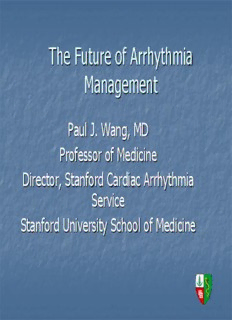
Paul Wang Future of Arrhythmia 2011.pdf - Chinese American PDF
Preview Paul Wang Future of Arrhythmia 2011.pdf - Chinese American
The Future of Arrhythmia Management Paul J. Wang, MD Professor of Medicine Director, Stanford Cardiac Arrhythmia Service Stanford University School of Medicine Share my thoughts regarding major problems and needs in Arrhythmia Diagnosis and Device Therapy My thoughts about What we need to know Speculate about Timeline of the Future Encourage you to join in innovating for the future AHA Mission Reduce Cardiovascular Death (36% of all deaths) Reduce Cardiovascular Morbidity I need to convince you these are major problems Direct and Indirect Cost of Heart Disease $430 Billion Atrial Fibrillation 2.2 Million Heart Failure 5 million Sudden Cardiac Death 300,000 Arrhythmia device industry exceeded coronary stent expenditures $5 Billion per year A 20 year old man, who is a college basketball player, runs across the basketball court. He collapses. He is found in ventricular fibrillation. An Automatic External Defibrillator is used and he is resuscitated. What advances made this possible and what are the future needs in the field? Sudden Death Over 1,000 death per day in U.S. Survival decreases by 10% with every 1 min to defibrillation Most common cause coronary artery disease/left ventricular dysfunction Cardiomyopathy, hypertrophic cardiomyopathy, right ventricular dysplasia, anomalous coronary arteries, long QT, aortic aneurysm, Brugada syndrome, idiopathic VF, Commotio Cordis Poor Survival from Cardiac Arrest Survival from cardiac arrest VF< 10% 7-10% decline in survival per minute Strategies to Decrease Sudden Death Disease prevention Identify patients at risk Decrease likelihood of arrhythmia – drugs, ablation Respond to arrhythmia – implantable defibrillator Improve resuscitation Improve monitoring Improve response to arrhythmia SCD/year in the US 100% 90% Post MI High Risk 80% Prior Cardiac Arrest 70% CHF 60% Post MI Low 50% ? Risk 40% General Population 30% CAD No MI 20% General Population 10% 0% From Myerburg Role of Automatic External Defibrillator Automatic external defibrillator- designed for layperson use to automatically detect ventricular tachycardia/ventricular fibrillation and shock patient
Description: